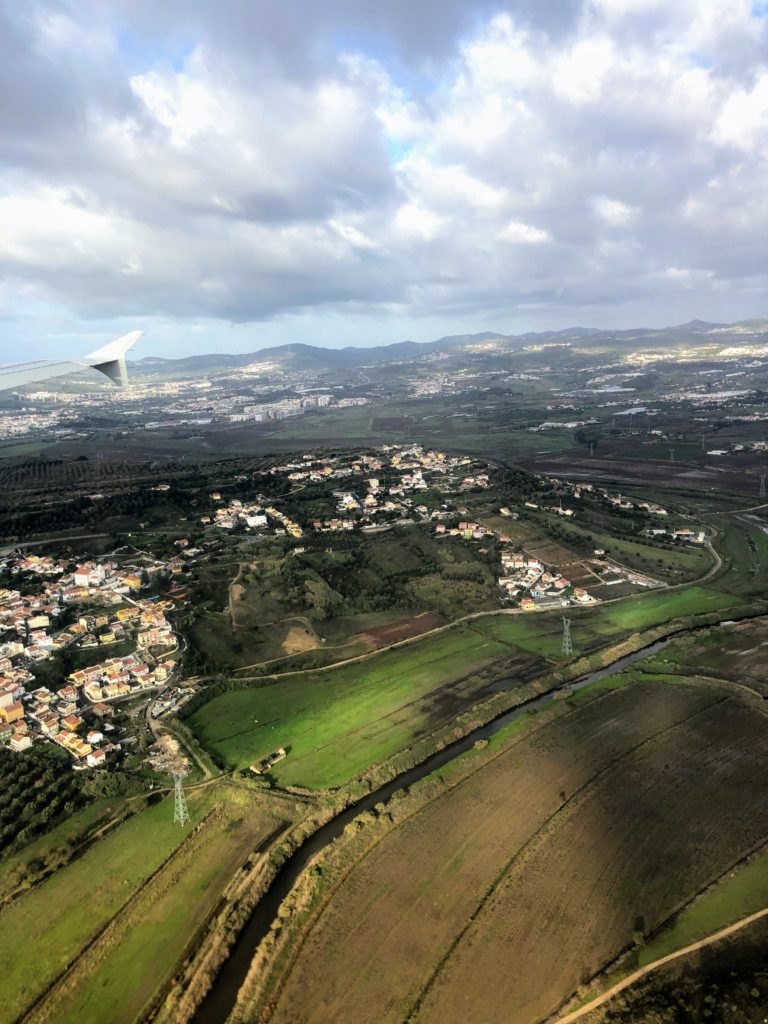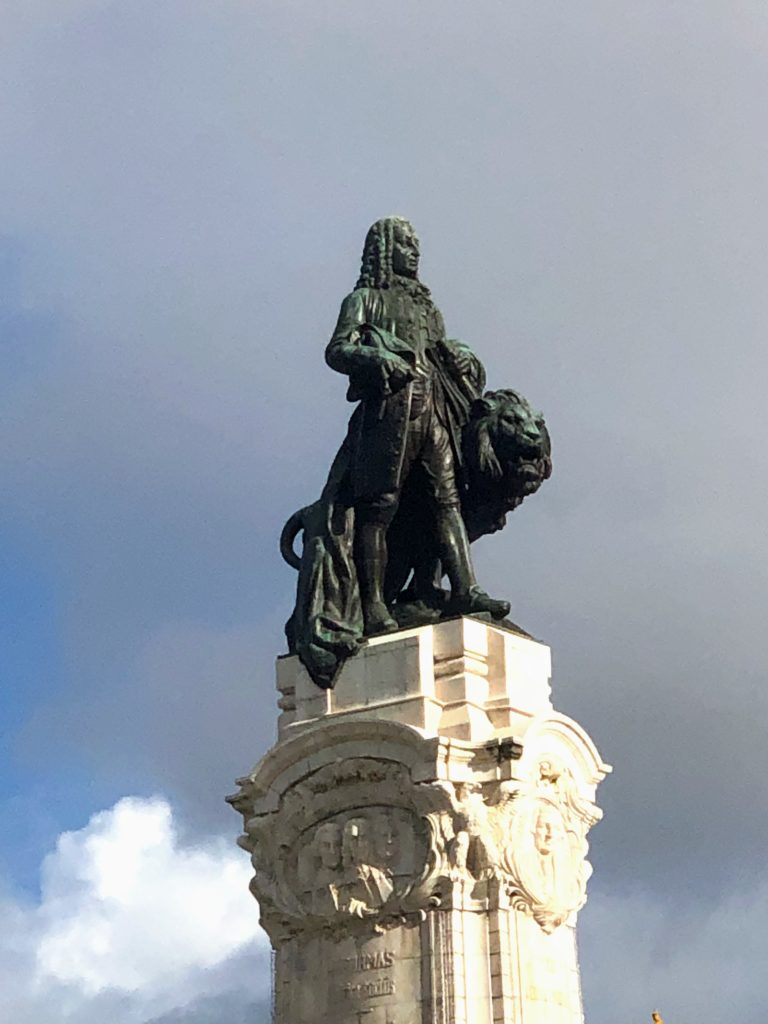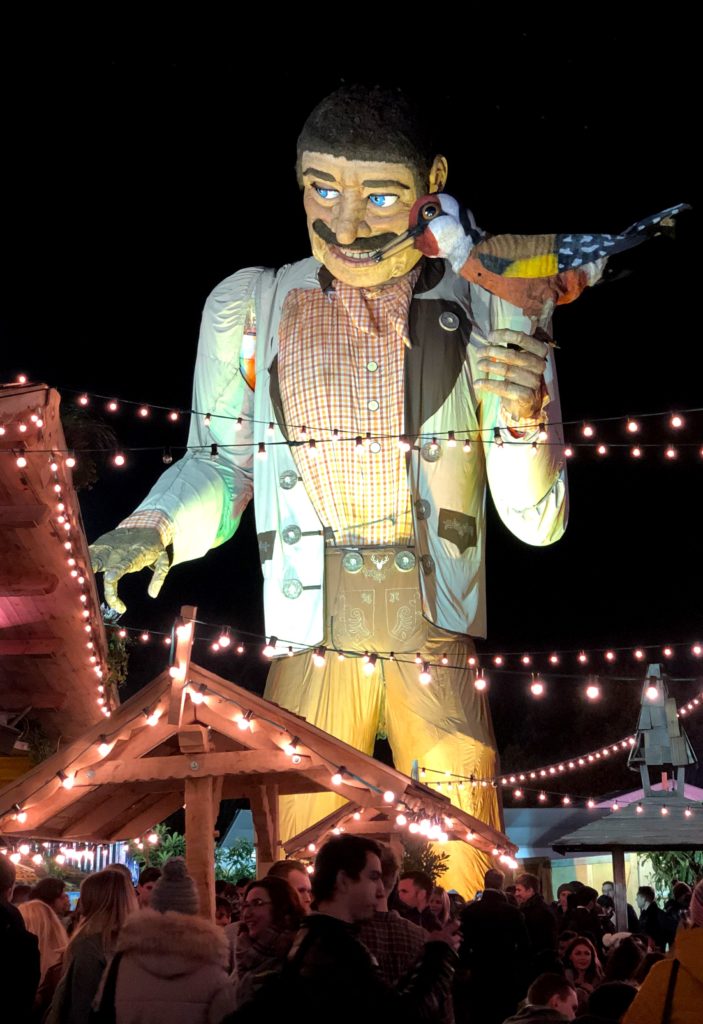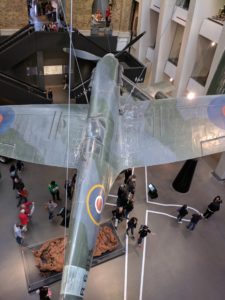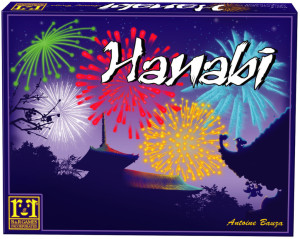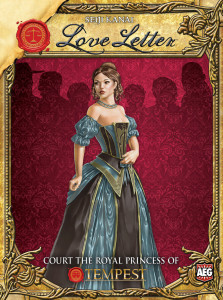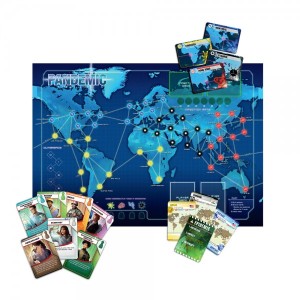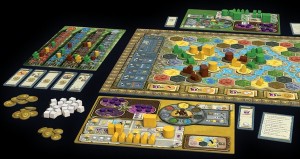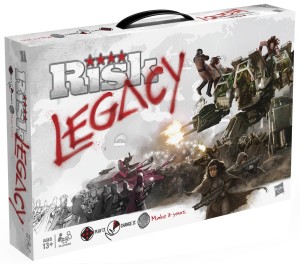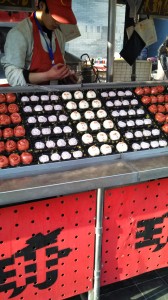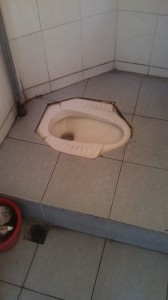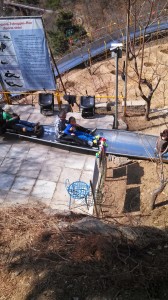- Below 0 – Stay inside
- 0 – Wear a coat, scarf and gloves
- 5 – Wear a coat and a scarf
- 10 – Wear a jacket. Or a coat. Your call.
- 15 – Wear a jacket
- 20 – Wear a jacket if you’re standing around
- 25 – Leave the jacket at home
- 30 – Wear shorts. Stay hydrated.
- 35 – We definitely need air conditioning now
- 40 – What is this, Arizona?
- 45 – Leave Australia, return in 6 months
Category: Writing (Page 4 of 6)
We spent four days in Paris the weekend between Christmas and New Year’s. It was beautiful, not very busy, and cold.
The Eiffel Tower: worth climbing to the second floor for sure. The line for the stairs was much shorter than the elevator, so we took the stairs. There’s no choice but to take an elevator further up if you wish to go to the top. We did. No regrets, but it’s not really necessary, either. The second floor is impressive on its own.
Versailles was even more ornate than I expected. I’d like to visit in the spring or summer to see the gardens. I booked my tickets in advance, which meant I was able to spend 5 minutes in the queue rather than an hour (said queue is surely much worse in warm weather), but the really pro way to see Versailles is book a tour in your language. That lets you enter with your tour group, and then you can stay inside the gates and view the rest of the palace on your own without needing to back out to the queue. You need tickets to enter whether you do the tour or not, but the tour is worthwhile in its own right, and the ability to skip the queue is a nice bonus.
The whole time I was there I couldn’t help but think about how such ridiculous excess ultimately resulted in the French Revolution.
The Louvre would be worth seeing if all the art and artifacts were removed. The building itself is gorgeous. No one does ceiling moldings like the French. Again, book your tickets in advance. The worst queue here wasn’t to enter the museum itself, it was to get through security. If you enter through the Lions’ Gate or another side entrance, you can drastically cut down the time you wait. You can also book timed tickets, which we did; we had to wait for all of five minutes.
I’m not sure if you can book Notre Dame ahead of time. If you can, and you want to see the inside, you should. We wandered around the outside and skipped the inside due to lack of time for the queue. Basically, if you want to see anything in Paris, book ahead of time.
Also, research your restaurants in advance. We picked a random spot for our first meal just because it was near our hotel. I will charitably call it mediocre and accurately call it over-priced. I spent an extra ten minutes looking for food for subsequent meals with much better results.
Spend the extra ten minutes is pretty good dining advice anywhere. Download Yelp (for the US) or Trip Advisor (for Europe) and look at some reviews. See how a place rates. If it’s not in the top 10% in its city, consider something else unless you have inside info. Also look at the 1-star reviews and see if they are coherent and whether they address the same things. I’m perfectly willing to ignore bad reviews if they are reflective of staff having a bad day, but I’m less inclined to ignore them if multiple people mention quality declining over time.
Take some binder clips to hold your packets together. There’s lots to read, and you’ll be dragging papers around.
Take warm, comfy clothes. It gets chilly downstairs. I bought a hoodie on the island and wore it practically every day. No regrets.
Take good walking shoes. You’ll likely be doing a fair bit of walking, whether it be to town and back or out for your 1 on 1s.
Take the time you need to meet your critique and creative obligations, but don’t be afraid to take that time in the common room with headphones on. If I have one regret, it’s that I spent Wednesday afternoon–and especially Wednesday evening–holed up in my room getting work done when I could have been more social while still getting my work done.
Do not miss out on Steven’s pies. Or the fudge.
You’ll have a chance at leftover curry, but go back for seconds, anyway. It’s worth it.
The calendar says that it is nearly winter, but the weather feels as if winter has already arrived. At the same time, it’s hard to believe we’ve been here for five months and that Christmas is only two weeks away. The girls were having a similar conversation last night, and it made me think about what we did in November.
On November 1, I captured a video of the autumn rain. I didn’t record this thinking it would make a good intro to a blog post, but play this thing on loop. It’s incredibly relaxing.
Technically, bonfire night was on the 5th, but London celebrated in style on Saturday the 3rd. The girls and I went to Battersea Park and took in the biggest fireworks show I’ve personally seen. It was truly a delight.
The following week took me to Dublin for work. Traveling for work generally means long days and little time to enjoy the place I’m visiting. The museums and cultural attractions are typically closed by the time I leave the client office, but I usually manage to find a decent meal, a drink, and then see whatever I can. In Dublin that meant this guy:
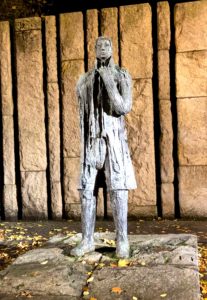
And of course a pint of Guinness.
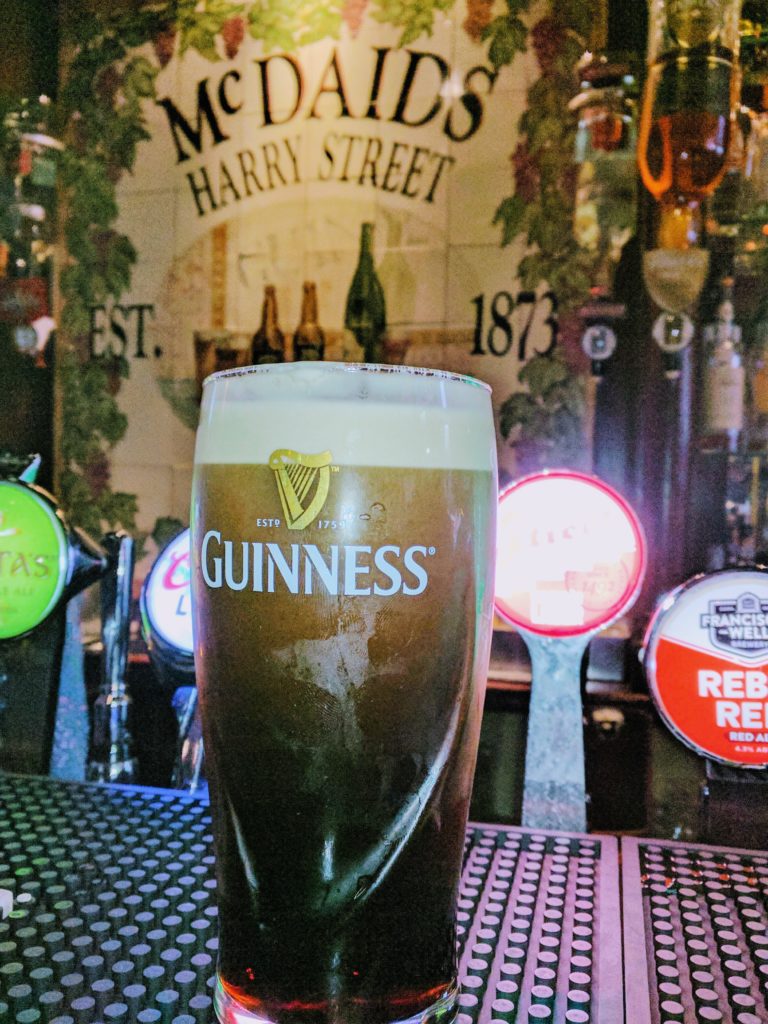
I didn’t like Guinness in America. I tried it a few times, but it always tasted slightly burnt. When I came to London, I tried it again. It was better! Creamier and that burnt flavor was gone. Then I tried it in Dublin. Reader, a pint of Guinness in a busy pub in Dublin might just be the best pint of beer of in the world. (I am open to suggestions otherwise!) It’s like drinking a hug from an angel. Like warm sunshine on a cold day. Like a nice, long piss after… well, you get the idea. It’s not remotely the same beer as America. I realize folks have lots of reasons for not consuming, and I respect that. However, if you enjoy a pint now and again, you’ll be hard pressed to find a better pint anywhere.
The following weekend Carissa and I managed to get out of the house for a few hours for a date night. We saw Dessa in concert, and the show was delightful.

Dessa has her own, distinctive sound that covers ground between indie, hip hop, and pop. I enjoy music as a neophyte. I do not catch the complexities of composition, and I cannot carry a tune in a bucket. What I do especially love are clever lyrics, and Dessa’s lyrics are razor sharp. We had a delightful time supporting our fellow Yank.
Toward the end of the month I made my first-ever trip to Portugal. As with any work trip, the pictures are A: photos from airplane windows, or B: inanimate objects. I need to work on this.
Lisbon was great. Warm weather, friendly people, great food.
My biggest challenge was the language. It turns out that all those years of Spanish have left me in a spot where I can almost sort of understand Spanish if people speak slowly, but completely confused me for handling Portuguese and its pronunciation.
Enter Scene: Brent walks into a small, family-run cafe.
BRENT: Buenos dias. Una taza de cafe, por favor.
WAITER, in English: Sir, this Portugal. We speak Portuguese. And your Spanish is atrocious.
BRENT: Uh, I’ll have a glass of water. Please.
That story may not have actually happened, but it is true nonetheless.
The final day of the month saw me back in London, and the girls and I went to Winter Wonderland at Hyde Park.
- Winter Wonderland is lovely
- Winter Wonderland is crowded
- Winter Wonderland is expensive
- We plan to go back next year
The girls went ice skating, and we all went through the magical ice forest. It was cold. It was also magical. There were rides. There was bratwurst. There were CHURROS!
The park is a “Christmas” carnival, which means it is an exercise in capitalism in its purest form. They let you in the gates for free, but everything from there has both a queue and a cost. The place was absolutely jammed with people by the time we left around 9:00 PM, but we still had a lovely time, and the girls want to go back next year.
If nothing else, for the churros.
It’s been six weeks since Viable Paradise ended. It feels like yesterday. It also feels like a lifetime ago.
Before I went to the workshop I read a bunch of blog posts from other students. One of the things I noticed was how many of the blog posts occurred weeks or months after the workshop ended. People wrote about how they needed time to process things, how they just weren’t ready to write about the things they had learned. It seemed weird to me then, in the before time. It doesn’t seem so weird now.
Moment: sitting in a critique group with my classmates, listening to people passionately discuss a story about a black woman in prison. Hearing Nisi’s feedback and seeing a glimpse of a world I didn’t realize existed.
When you step off the boat on Martha’s Vineyard, you leave behind whatever else is happening in your life. For that week all that matters is making good art. Work can wait. Family can wait. It’s like emerging from the wardrobe into Narnia where the forest is covered in ice and strange creatures are prowling just out of your sight. Only the island is covered in autumn leaves and the strange creatures make a damned fine curry.
Moment: walking along the beach with The Oracle of the Buses and discussing how trying to twist a trope can still give power to the trope.
The workshop occurs on an island that exists outside the regular flow of time. There are so many people to meet, so many stories to read, so much to learn. I arrived late on Saturday evening, and approximately one month elapsed before dinner on Tuesday . I blinked sometime after dinner, and it was already Friday afternoon, and I was scrambling to escape the nor’easter bearing down on the island.
Moment: reading novel chapters that are so good I can’t believe they aren’t published
I have notes. I always have notes. I write because it helps me order my thoughts and it helps me retain what I hear. Lord, do I have notes.
The staff remind you on day one that you deserve to be there. You were invited to attend because your work was good. There was a conversation one evening about Imposter Syndrome. Every single person in the room had it to one degree or another, including the ones with their names on the covers of best-sellers. That was strangely reassuring.
Moment: hearing critiques of those novel chapters that want to change the parts that I loved
Over the last few years I’ve read a number of books on craft. Dozens. The best books help you see things differently each time you read them. Many of the lectures at VP cover topics that exist in the craft books. There’s a difference between reading a thing a few times, hearing a thing a few times, and discussing a thing with someone that has been doing the thing professionally for decades and has incorporated it into their writing DNA.
Moment: listening to one of my writing heroes discuss the financial realities of a career in the genre.
The instructors are wonderful. There were a few that were not part of my critique groups or one on ones, and they each made a point to chat with me during the week. I don’t know the best advice I received, but I know the piece that felt most real. It had nothing to do with craft and everything to do with the realities of living in a world where obligations and art must compete for the scarcest resource of all: time. The advice was that when you get ready to be a full-time writer, see if you can reduce your hours at your day job to be part-time for a while. This will help with cash flow, but it will also help transition to a new routine without a single enormous shake-up.
It was good that the island existed for a week outside the ordinary flow of time. Not everything would have fit, otherwise.
Oh, hello again.
Some things are changing around here. I’m moving from southwest Missouri to London, UK this summer. There will be more blog posts. Expect to hear lots about museums, food, travel, and general life in a place that is very different from my corner of the Ozarks.
There is a novel in-progress. It’s a sprawling thing that isn’t quite science fiction, isn’t quite fantasy, is definitely not Hamilton fanfic, but is definitely inspired by the American Revolution, wealth inequality, steampunk, and the month I cooked vegetarian food. “Sounds weird,” you’re thinking. “But I like weird. When can I read it?” Now that, dear reader, is a good question. I don’t have a good answer. “Someday” would definitely be accurate. “Next year” would be too ambitious. I’m planning to send this one out to the major publishers when I feel like it’s ready. It may well be years before it’s either published or I give up on selling it and publish it myself. Don’t hold your breath, but keep an eye on this space for updates.
There’s also another Porter Melo story kicking around in my head, but I probably won’t write it until Prosperity, LTD is out on submission. The Porter Melo story will be about soccer, FIFA corruption, and organized crime. Probably set in London since I’ll be able to do plenty of onsite research. This one I likely will self-publish. Ideally it will be available before the 2022 World Cup.
I do have a new story available Right Now, though. It’s only available in paperback, and you can find it in the Santa Barbara Literary Journal at Amazon. The story is titled “Petunia’s Baby” and it’s about a young lady that falls in love with the wrong sort of man, realizes that the world doesn’t owe her anything, and finds her own happy ending. Spoiler alert: things get dark, fast. If you’ve read “Who We Once Were, Who We’ll Never Be” (my story about the young lady in China), you’ll notice some similarities. Look, I won’t pretend that these aren’t my way of trying to send not-so-subtle messages to my daughters. Kick ass and take names, ladies. And have an alibi.
Hello revolutionaries,
I have a new short story available at Flash Fiction Online. The Disposition Matrix is a near-future sci-fi piece. Not quite dystopia, though not exactly the world we know. It’s a quick read, only a few pages, but has a nice little punch at the end. Enjoy!
It’s been a while since my last boardgames post and I’ve played a number of other games in the last two years. Many of these games aren’t exactly new, but they’re new to me.
Some new favorites:
Hanabi
This is a cooperative card game with a unique twist. You don’t see your own cards until you play them. There are five colors of cards (plus a bonus rainbow color for advanced players) with numbers one through five. The goal is to play all five colors in order from one to five. Each player gets a turn and they have one of three actions. The player may give a clue to another player. The player may play a card from their hand. The player may discard a card. Players win by playing all twenty-five cards or by getting through the deck without four misplays. There are some limitations on the kinds of clues and the number of clues, but it’s a very elegant set of rules.
The game is deceptively simple, and there are layers of strategy in which clues a person provides, who receives clues and even how long it has been since a person has received a clue.
This a fascinating game, and I highly, highly recommend it.
Love Letter
Another fairly quick card game, but not cooperative. In this game there are eight types of cards ranging from a lowly guard all the way to the princess. The theme is that the player is trying to send a letter to the princess, and the person that sends her letter as close to the princess as possible wins the round. The players start with one card in their hand and then draw a single new card each turn. Each type of card has a unique effect, and the player must always play one card. There’s a good bit of interaction between players, and the rounds move very quickly. My girls love the game, though I’m not quite as crazy about it. The randomness of the card draws has just as much (or more) outcome on the game as the individual player’s decisions. This makes it fun for newer (or younger) players, but it gets old for those with more experience.
It’s fun, but simple, and well worth consideration.
Pandemic
Pandemic is an older game, but my group has only recently started playing it. We immediately loved the theme of CDC researchers trying to stop the world’s destruction by multiple viruses. The game requires good communication and good coordination in order to succeed, but even then there are no guarantees. Some of the role cards are significantly stronger than others, so if you’d like an easier path into the game, consider selecting some of the more powerful roles.
I love this game. The theme, the teamwork, the nailbiting tension as the draw deck dwindles and too many infections remain on the board. It’s a blast and a must-play.
Terra Mystica
In Terra Mystica you are playing as one of 14 different factions. The victory conditions are the same for every faction, but there are some differences in how they get there.
The basic goal of the game is to terraform land, build buildings, lead a cult, and score victory points. The game happens over the course of six (or maybe it’s seven, I don’t remember exactly) rounds. You get points along the way for leading some faction of the cult (Wind, Water, Earth, Fire) or building certain buildings.
The buildings themselves are pretty amazing. You have the settlement, recognizable from Settlers of Catan. It upgrades into the “trading post,” recognizable as the city from Settlers of Catan. The trading post upgrades to a Stronghold, recognizable as a squarish wooden thing, not from Settlers of Catan. Or if you’re feeling cultish, the trading post instead upgrades to a temple, recognizable as a round wooden thing that could belong to any other game ever. And finally the temple upgrades to a more expensive temple, not substantially different than a regular temple, called a sanctuary.
The real clever bit here is that your buildings are all on a little mat in front of you, and much like in Eclipse, when you place a building on the board, you then get paid the resources that the building was previously covering on your mat. Your settlements provide workers. Your trading posts provide money and “power.” Your strongholds provide something unique for each faction. Your temples and sanctuaries provide priests each turn, but also each one you build allows you to a gain a favor, and the favor itself provides various things including one time perks and recurring resources. The real key here is that you have to expand territory to put out new settlements, and those settlements provide additional workers, but when you upgrade the settlements, you put them back on your little mat, and you lose the worker income. So the game becomes a balancing act between going horizontal into more territory or vertical into better buildings.
There are four currencies in the game. One is money. It’s just… money. But money can’t buy you love, and neither can it buy you buildings unless someone actually builds them. So money gets used with your workers from your settlements to upgrade your buildings. Once you build temples, you get priests. They are used for things like building a navy (because buggery?) or incurring favor with the cults. Along the way, various things give you “power” and this is the most interesting currency, at least from a “I haven’t see anything work like this before” perspective.
Power is a finite resource on your playing mat, something like 14 little purple chips. These chips live in a set of three connected circles cleverly numbered 1, 2, and 3. They start in some combination of circles 1 and 2. The gimmick is that to spend them (which lets you do things and also moves the chips back to circle 1), you need chips in circle 3. And you can only move chips from 2 to 3 if all the chips are gone from circle 1. You can use power to gain extra money, extra priests, extra workers, bridges (recognizable as the roads from Settlers of Catan) that allow you to link buildings across rivers, and a few other things that don’t spring to mind. Once you get an engine going to bring in resources, power gives you a good bit of flexibility.
At the end of the game you score points for your position on each of the four cultist tracks. You also score for the total size (horizontal; it ignores vertical) of the linked buildings in your empire. And I definitely missed that the scoring ignored upgrades the first time I played, so that hurt. Ultimately, it’s a very clever, very fun game that combines the best bits of several other games, adds some of its own and calls it a day.
Risk: Legacy
This is not the Risk of my childhood. Yes, there’s still some dice rolling, and yes, Australia is still really strong, but there are so many changes that game only bears a passing resemblance to its namesake.
The biggest, most unique aspect of the game is that you the player will permanently alter the game every time you play it. At the very beginning of the game the players start by customizing their starting factions. Each faction has a sticker sheet with some abilities on it, and you only use part of those stickers. Once they are put on the faction’s card, they are permanent, and the others are thrown in the trash forever and ever amen. This is a theme that repeats itself through out the game. Events happen. Players respond. The game forever changes.
The second amazing aspect of the game are the “surprise” bins. The box ships with a number of sealed compartments. You are only supposed to open those compartments when the events listed on the compartment occur. This can be something like putting thirty armies on the board or using three nuclear missiles in a single combat or creating a special city. The boxes contain new cards to add to the game, new rules to put into the new rule book and all manner of wondrous and amazing things.
One of the single best moments I’ve had in any board game was when one of my regular gaming buddies and I got into a fight over a third buddy’s capital. The fight triggered an event, and it permanently modified that space on the board. It. Was. Glorious.
Unlike the Risk of yore, the game finishes when the first player acquires four tokens. At the beginning of the game (as in when you first start playing it), each player starts with one of these tokens, so victory can occur by capturing only three enemy capitals. No needs to conquer the whole world; only their nearest neighbors.
The game is intended to played fifteen times before the board stops changing. It’s been a blast getting to fifteen, and while there’s no reason to stop, I’m more likely to buy a new copy of it and start over from scratch. I really enjoy Risk: Legacy, and if you’re into wargames, you should take a look at it.
Blogging is one of those activities that’s deceptively simple. How hard is it to write a few hundred words a month and keep people up-to-date on things? Hard, apparently. Because my first professionally published short story came out two months ago and I’m just now posting about it. (Though if you follow me on twitter @dbrentbaldwin you would have heard about it long ago…)
Anyway, Who We Once Were, Who We Will Never Be is available from Fireside Fiction. It’s very short, only about three pages (or 750 words for my fellow writers), but it packs a punch.
The story itself is a result of my trip to China last year. One Saturday evening I found myself trying to find a cab at Luohu Port, and I decided to cut through an alley to get to a better intersection. Halfway down the alley I ran into a number women that seemed very interested in inviting me upstairs. It was a very eye-opening experience, and this story grew from the question of “what if things in the alley went terribly, horribly wrong?”
1. Loperamide
Lopermide is the generic form of Immodium. If you’re used to North American cooking and sanitation, and you go to China, you’re going to get the runs. It’s not a matter of if; it’s a matter of when. So plan on two loperamide for each day you’re in China. You may not need them, but it’s a guarantee someone else in your group will.
2. Antacids
You know, Tums. Because even if you don’t get diarrhea, you’re going to eat the street food (it’s amazing) and you’re going to want something to settle your stomach so you can keep snapping pictures and gawking at the splendor of Asia.
3. Travel packs of bathroom tissue
Yes, they have toilet paper in China. Most of the time. Except where the toilets look like this.
No, it’s not a hole in the ground. Yes, that’s a place you’ll need to take care of business. Okay, you’re right, it is a hole in the ground. And guess what, it doesn’t come stocked with TP. Bring your own.
4. Melatonin
Jet lag is a real thing. It took me about four days to get over it when I traveled from the US to Shenzhen. Doze on the plane a little, and when you land in China try to stay up until 9:00 PM so you can get on a Chinese schedule. And while you’re at it, don’t plan your trip to the Great Wall on the first day you’re in the country. You’ll be too tired. Go see the local sights for the first couple days, and don’t push too hard.
5. Nyquil / Dayquil
You’ll get sick. Or someone in your group will. Pack some flu medicine just in case.
6. Bandaids and Neosporin
At Mutianyu there’s a toboggan and it’s awesome and I totally fell out of my little chair and scraped all the skin off my left knee.
It was a really shaky chair, okay? I’m sure they have bandaids and Neosporin in China, but they won’t have them wherever you actually get injured.
7. A Book
Yes, you’re in China, and yes there’s plenty to do, but the plane ride from Chicago to Hong Kong is 16 hours. The selection of movies was surprisingly good, but you’ll still want to take a break from staring at that tiny screen.
8. Snacks
If you have kids, bring some familiar snacks. Granola bars or fruit chews or whatever it is the kids like. Chinese food in China is not the same as Chinese food in the US. (Caveat: I’m in a moderately sized city in the Midwest; there’s real Chinese food on the coasts.) You will not find the General Tsao’s chicken you expect. And while this is fine for adults, any kids–especially ones that are picky eaters–will appreciate something familiar, even if it’s a snack.
And seriously, so will you, Mr. Grown Up that thinks you can handle Chinese food. Give yourself a week a week in China and see how you feel after you get grease stains on your two favorite pairs of pants. See how you feel when the bird flu (i.e. minor cold) you caught on the plane really takes hold. You’ll be happy for that package of Fruit Roll Ups you stashed in your bag.
9. The Google Translate app with the Chinese language pack installed
The ability to type in “cold water” and have it come back with 冷水 is a life saver when you’re exhausted and thirsty and a tiny glass of hot tea just won’t do. Don’t be a horrible tourist and assume that saying something louder in English will make the non-English speaking Chinese waitress understand. Just whip out the phone and show her what you want.
If you install the language pack over wifi (or before you leave), there’s really no need to get the expensive overseas data plan if you have Verizon or AT&T back home. And while you can get a SIM card for cheap, keep in mind that mainland China and Hong Kong use different cell networks, so if you’re visiting both you’ll need two sets of SIM cards. And you’ll need your phone to be unlocked.
10. A sense of adventure
You’re in China. Things are different. Embrace the differences and enjoy the experience. Try the street dumplings. Gawk at the scorpions on a stick. Just be smart and be prepared.
